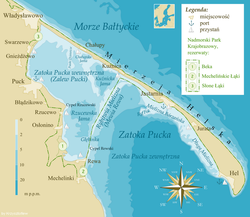Hel, Poland
- for other meanings, see also the disambiguation page Hela
Hel | |
|---|---|
 Old fisherman house on Wiejska Street | |
 | |
| Country | |
| Voivodeship | Pomeranian |
| County | Puck |
| Gmina | Hel (urban gmina) |
| Established | 12th century |
| Town rights | 1351-1872, 1963 |
| Government | |
| • Mayor | Mirosław Wądołowski |
| Area | |
| • Total | 21.27 km2 (8.21 sq mi) |
| Population (2006) | |
| • Total | 3,898 |
| • Density | 180/km2 (470/sq mi) |
| Time zone | UTC+1 (CET) |
| • Summer (DST) | UTC+2 (CEST) |
| Postal code | 84-150 |
| Area code | +48 58 |
| Car plates | GPU |
| Website | http://www.hel.eu/ |
Hel Template:Audio-IPA-pl (Kashubian Hél, German Hela) is a town in Puck County, Pomeranian Voivodeship, Poland, located on the tip of the Hel Peninsula, some 33 kilometres from the Polish mainland.
History
Early developments
The Kashubian village of Hel was first mentioned in 1198 as a centre of herring trade area named Gellen. In one of the Danish chronicles of 1219 it is mentioned that a damaged ship of King Valdemar II the Victorious was set ashore on an "Island of Hel". By 13th century the village became one of the most important trade centres of the area, competing with the nearby town of Gdańsk. It was then that the village was granted city rights by Duke Świętopełk II the Great of Pomerania. The privileges were later confirmed in 1378 when the town came under the rule of the Teutonic Knights.

Initially the town was located some 1.5 kilometres from its present-day centre. It contained a church, hospital, city house, two market places, several guest houses and a small port. However, during the 15th century the peninsula started to shrink through marine erosion and soon the town was relocated to a safer location. In 1417 St Peter's Church was built in the town, devoted to the patron saint of fishermen. Hel experienced a period of growth, but was later left behind by the faster growing city of Gdańsk. In 1466 King Casimir IV of Poland granted the town as a fief to the rulers of Gdańsk, which ended the century-long struggle for economical domination over the Gdańsk Bay. In 1526 King Sigismund I the Old withdrew all privileges previously granted to Hel and sold the town and the peninsula to the city authorities of Gdańsk. Since then Hel's fate was tied to the fortunes of its bigger neighbour.
In the 17th and 18th centuries prolonged warfare and a series of natural disasters severely damaged the town. It was severely depopulated and in 1872 the government of the newly-formed German state abolished the city rights granted to Hel six centuries previously. After that the village of Hela (as it is called in German) lost much of its significance.
Modern times
The period of decline was halted in 1893 when a fishing harbour was built in the village. It provided a shelter for fishing vessels, but also became a popular destination for weekend trips of the inhabitants of Gdańsk and Sopot. In 1896 the village was granted the status of a sea-side resort.

As a result of World War I and the Treaty of Versailles Poland was re-established as an independent nation, Hel became part of Poland. In 1921 a new railway was built along the peninsula connecting the town to the mainland. The authorities of the Pomeranian voivodship also planned to build a road to the village, but the peninsula was found too narrow at the time. Soon Hel became one of the most important tourism centres in Polish Pomerania. New suburbs of villas were built for tourists, as well as a new church, school, fishing institute and geophysical observatory. In addition, the village became one of the two main naval bases of the Polish Navy. The harbour was expanded and in 1936 the president declared the peninsula a "Fortified Area" under jurisdiction of the Polish Army. The naval base was expanded significantly and a battery of coastal artillery was built to provide cover for the military facilities.
During the Invasion of Poland the Hel Peninsula was one of the longest-defended pockets of Polish Army resistance. Approximately 3,000 soldiers of the Coastal Defence Group (Grupa Obrony Wybrzeża) units under Kapitan [Stanislaw Zwartynski]"The Defender of Hel" defended the area against overwhelming odds until October 2, 1939. Shortly before capitulation, Polish military engineers detonated a number of torpedo warheads, which separated the peninsula from the mainland transforming it into an island. During World War II the Kriegsmarine used the Hel naval base to train U-Boat crews. At the end of the war the village was the last part of Polish soil to be liberated: the German units encircled there surrendered on May 10, 1945, two days after Germany capitulated.

After the war the village yet again became a naval base. In 1960 a road linking Hel with Jastarnia on the mainland was built. Three years later city rights were reintroduced. Since then the tourist industry started to recover and several hotels, guest houses and pensions were built. In 1996 the Polish Navy sold all remaining parts of the peninsula to the civilian authorities and only a small naval base is located there today.
The harbour now serves primarily as a yacht marina. Hel houses a sea life biological laboratory and there are interesting examples of naval armament and equipment exhibited throughout the town.
The most easterly edge of Hel, which was once a military territory, can now be accessed by the general public making it possible to walk all the way around the peninsula.



